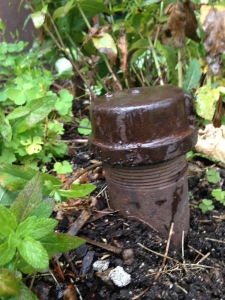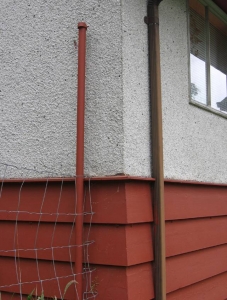What to Look For?
There are a couple telltale signs that you may have on your property that may suggest the presence of an oil tank.
Please visit our gallery to check out different types and styles of oil tank pipes, switches and other signs that may be present at your home.
Suspicious pipes:
Unfortunately, it is a common occurrence to find that the previous homeowners have removed the oil tank pipes on a property.
A few reasons may be, but are not limited to:
- Tripping hazards
- To save the lawn mower blade when mowing the grass
- Aesthetic purposes
- Renovations
- Not knowing what the pipe was for
- To hide the evidence of a buried oil tank on the property
- A previous abandonment of your oil tank
The following indicators are things you may see at your property if you have an oil tank present:
The purpose of this pipe was to fill your underground storage tanks (UST) with oil. They are usually approximately 2-¾ inches diameter and are typically 6 to 8 feet from the original structure.
For examples, please visit our gallery and check out many different types of filler pipes.
This pipe was used to vent excess fumes from the interior of the oil tank to help prevent the risk of explosion. Additionally, this pipe also allowed airflow into the oil tank aiding in the conveyance of fuel oil into the oil burner through the feeder lines.
The vent pipe is usually attached to the house vertically and slopes to the opposite end of the oil tank than the filler pipe. The vent pipe is usually 1-¾ inches in diameter and has a open cap on the top of it.
The partially open cap on top of the vent pipe blocks water and debris from entering the tank and allows air to flow freely without interruption.
For examples, please visit our gallery and check out different types of vent pipes.
Feeder lines ( Supply Lines)
These pipes fed the fuel oil into the oil burner from the oil tank.
Feeder lines are usually made of copper and are approximately ¼ to ½ inches in diameter.
Usually an Underground Storage Tank (UST) will have 2 feeder lines and Aboveground Storage Tanks (AST) will have 1 feeder line.
The feeder lines for Underground Storage Tanks are usually buried underground, so the spotting them can be difficult.
When looking for feeder lines, the most common areas you may find them are near the furnace or foundation wall.
Many times thes pipes were removed during renovations, or when the house was converted to natural gas.
The visible signs of feeder line removal that may be present are:
Crimped lines coming out of the floor near your furnace or foundation walls.
Another sign that your feeder lines may have been removed, would be an unexplained area of replaced concrete that leads from the furnace to the foundation wall. This could indicate that someone previously dug in that area to remove the lines and replaced the concrete in that area.
For examples, please visit our gallery and check out our pictures of feeder lines.
The purpose of this switch was to cut the fuel oil supply to your oil tank to help mitigate or prevent damages in the event of an emergency.
This outlet box usually says emergency oil shut off on its face and has a toggle switch. The most common places to find this switch is in your basement, and/or near your furnace room.
For examples, please visit our gallery and check out different styles of emergency oil burner shut off.
Filler Pipe:

Vent Pipe:

Oil Tank Records: Is There Anyone I Can Call to See If My Property Has An Oil Tank
Some cities may have old records of oil tank installations;however, this information is not always accurate. This could be a result of lost information or that no permit was applied for or required at the time of installation.
Additionally, if your oil tank was removed within the last 15-20 years by an oil tank removal professional, there is a higher probabilty that the final report was sent to the appropriate governing body in your city. However, if the city did not file oil tank reports at the time, they may not have accurate records on file.
There are some resources that can be beneficial to contact while investigating the existence of an oil tank on your property, such as:
- Contacting your local City Hall to inquire if they have any records associated with the address of an oil tank being installed, removed, or abandoned.
- Contacting your local Non Emergency Fire line and inquire if they have any records of an oil tank being installed, removed, or abandoned at the associated address.
- Calling your local natural gas provider to determine when there service was installed and cross referencing the findings with the age of the house.
Although this information can be helpful when determining if there is a suspected oil tank on your property, these methods of inquiries should not be the sole means of your investigation.
Many times with older homes the accuracy of records surrounding the existance of an oil tank can be unreliable.
This is why it is important to get an oil tank detection.
.
